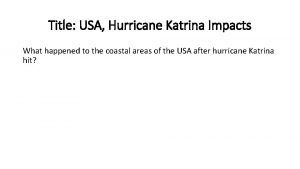Development of a HighResolution Flood Inundation Model of

- Slides: 1

Development of a High-Resolution Flood Inundation Model of Charles City, Iowa Matthew Moore Undergraduate Research Assistant matthew-moore@uiowa. edu MOTIVATION: NUMERICAL SIMULATION: Severe flooding in June 2008 caused millions of dollars of damage to the state of Iowa. As a response to the widespread damage from the flooding, The Iowa Flood Center was created to improve flood preparedness within the state. One of the communities particularly affected by the flood was Charles City on the Cedar River. A large number of homes and businesses were inundated and a historic suspension bridge also collapsed under the stress of the flood waters. One-dimensional (1 D) and two-dimensional (2 D) flood models were developed using the DHI Water & Environment MIKE 11 and MIKE 21 software, respectively. The models use depth-averaged continuity and momentum equations (known as the St. Venant equations) to simulate flood inundation. Boundary conditions were estimated using USGS-operated stream gage data as well as estimated recurrence interval discharges. Channel cross sections for the 1 D simulations were created using the DEM. The DEM was also used as the mesh for the 2 D simulation. DHI’s MIKE FLOOD software was used to reduce the amount of time required to simulate flood events by restricting the computational domain of the 2 D model to the floodplain and using the 1 D model to calculate in-bank flow. DATA COLLECTION: Stream channel bathymetry for the Cedar River was collected using a boat equipped with a single-beam echosounder. River bed elevations were georeferenced using a real-time kinematic (RTK) global navigation satellite system (GNSS). Where the water depth was too shallow to use the boat, the bathymetry was collected by wading into the channel and using a portable GNSS. Figure 4. A 2 -dimensional mesh used to model flow within the floodplain. RESULTS: PRE-PROCESSING: Topography was defined using high-resolution Light Detection And Ranging (Li. DAR) data acquired from the United States Geological Survey (USGS). Topography was combined with bathymetry to create a Digital Elevation Model (DEM). Additionally, land use values obtained from the National Land Cover Database were used to estimate friction resistance in the floodplain. The DEM and friction resistance map were then used as inputs to the flood inundation model. Flow rates representing the 2, 5, 10, 25, 50, 100, and 500 year recurrence interval flows (as defined by the USGS), and 0. 5 foot river stage intervals were simulated. Flood inundation extent and depth for each simulation were generated. Additionally, maps of velocity magnitude were generated. These data will allow more accurate and efficient mitigation of future floods. Figure 1. Bathymetric survey points collected by the single-beam echo-sounder. The points are displayed over an aerial photograph of a section of Charles City Figure 5. Cross sections of the channel developed from the DEM. Conveyance is calculated for each cross section resulting in a stage-discharge relationship. Figure 2. The bathymetry converted to a TIN. The TIN shows the 3 -dimensional geometry of the river channel. FUTURE WORK: Current results are preliminary. High water marks recorded during the 2008 flood will be used to calibrate the model. The friction resistance parameter will be adjusted until simulation results match the high water data. Additional bathymetry will be collected to increase the extent of the model which will allow the investigators to produce more accurate results. Structures such as bridges and lowhead dams crossing the stream will be added to the model, accounting for flow constriction and improving simulation results. Final inundation maps will be combined with real time rainfall data to forecast potential flooding hazards. Figure 6. Result of a 1 -dimensional simulation showing the water surface elevation along the length of the river section. Figure 3. The combined DEM with the bathymetry and Li. DAR topography. The combined DEM can then be used as an input to the flood inundation model. Contributing Authors: Nathan Young Associate Research Engineer nathan-young@uiowa. edu Jesse Piotrowski Engineer I Jesse-piotrowski@uiowa. edu Larry Weber Director, IIHR – Hydroscience & Engineering larry-weber@uiowa. edu Witold Krajewski Director, Iowa Flood Center witold-krajewski@uiowa. edu

